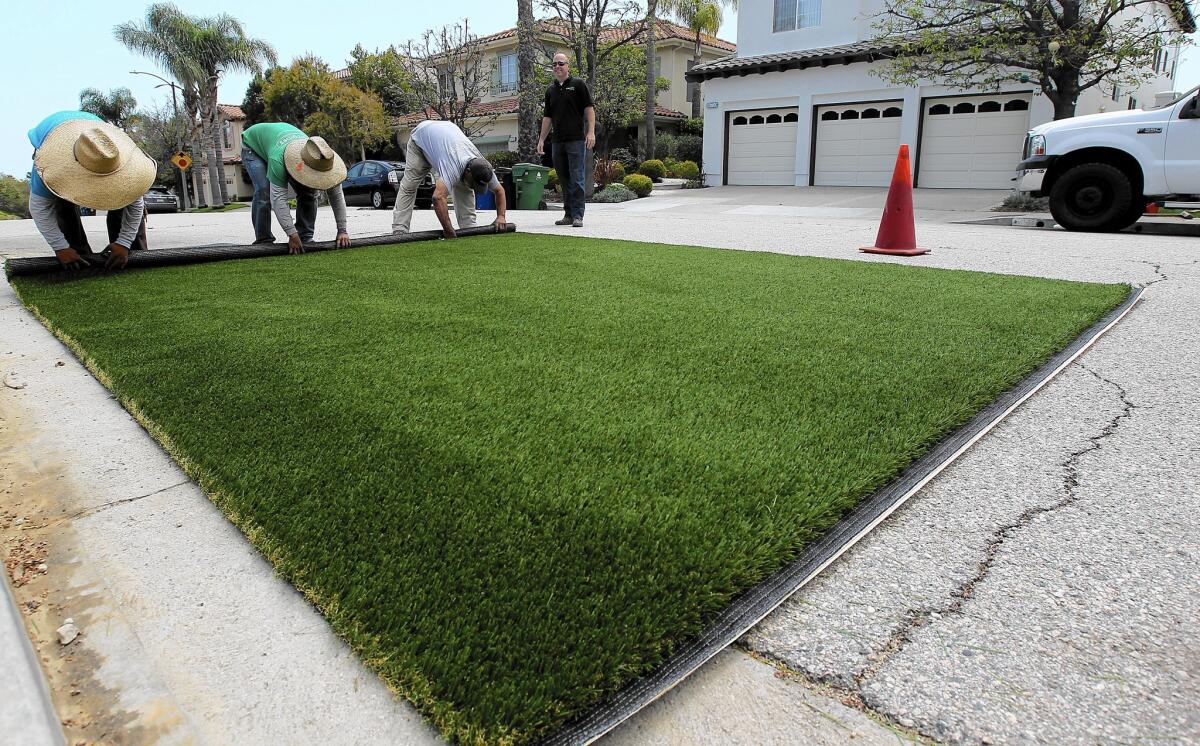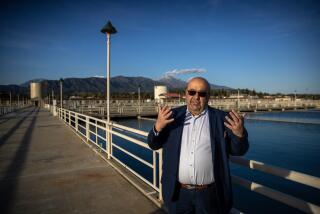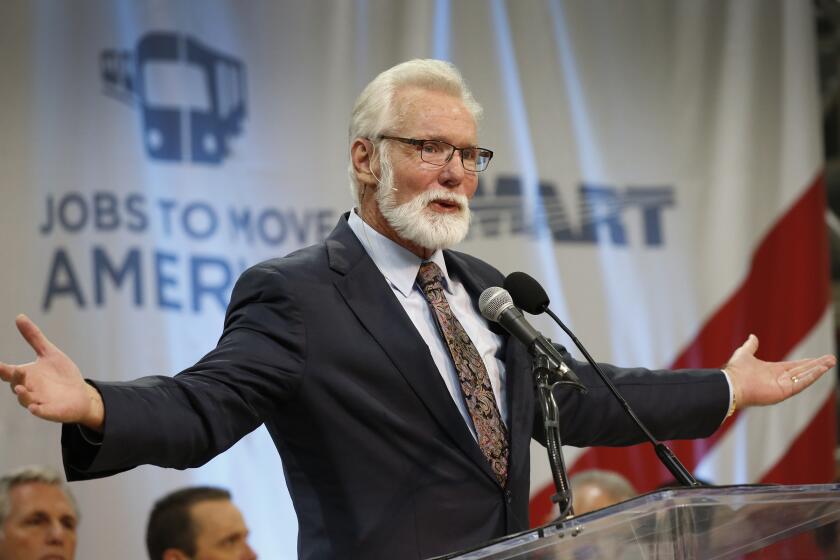Southland water importer OKs $350-million boost in lawn-removal rebates

- Share via
Responding to a surge of interest in removing grass amid California’s worsening drought, the Metropolitan Water District agreed Monday to spend an additional $350 million to help homeowners and businesses replace the turf.
The move comes as Gov. Jerry Brown has ordered urban water users to cut consumption by 25% and urged residents to replace water-thirsty lawns with drought-tolerant landscaping.
The MWD, which sells imported water from Northern California and the Colorado River to Southern California communities, took action after the turf replacement program ran out of funds this month. The MWD initially allocated $100 million for the program this year. But it has already received $330 million in requests for rebates.
MWD General Manager Jeffrey Kightlinger estimated the boost in funding would result in the removal of 172 million square feet of turf and save up to 80,000 acre-feet of water in the first year.
Kightlinger said this represented a “couple percent” reduction in water use across Southern California. But he said the savings was greater than other conservation efforts such as construction of a storage reservoir or desalination plant — projects that might take a decade to complete.
“This program is as shovel-ready as any program we’ve got out there,” Kightlinger said. “If we have approved funding … we can actually make changes on the ground virtually immediately.”
While approving more money for rebates, MWD directors elected to cap payments to residential landowners at $6,000 and to slash the rate of reimbursement available to commercial properties.
The reason: Although businesses made up only about 6% of program applicants in the last few weeks, they were seeking up to 80% of the total reimbursements, officials said.
“The thinking was, we should spread out the funds and impact tens of thousands of homes across California and not a dozen golf courses,” Kightlinger said.
The program, launched in 2008, is intended to encourage water conservation by paying homeowners and businesses to uproot grass lawns and replace them with drought-resistant landscaping.
Most of the additional funding will go to turf removal, but MWD’s conservation program includes rebates for water-efficient appliances and devices. Demand for those have also jumped since Brown ordered a cut in urban use.
Under the modified program approved Tuesday, residential property owners will be reimbursed at a rate of $2 per square foot of turf, although commercial properties will be reimbursed at half that rate. Businesses will also be limited to a maximum payout of $25,000 annually.
Before, residential and commercial properties received $2 per square foot, with no payment cap.
Craig Kessler, director of governmental affairs at the Southern California Golf Assn., said the organization expected the reduction in commercial rates.
“The goal was to immediately remove turf, and golf courses were uniquely suited to remove massive amounts of turf in a very short period of time,” Kessler said when contacted after the meeting. “We always understood that it wouldn’t last forever.”
Kessler added that he was pleased the board chose annual, instead of lifetime, caps on commercial rebates.
Just before Tuesday’s vote, environmental advocates said they supported the budget increase, but some argued that commercial rebates should be further reduced and outreach efforts should be increased in low-income areas.
MWD officials said that 36% of residential turf removal program dollars are going to “disadvantaged communities.”
Board member Michelle Martinez, who represents Santa Ana, said the board can do more to increase participation in these areas. Martinez pointed out that many residents don’t have access to a computer in order to apply for rebates.
“We need to make sure that we’re able to do as much outreach as possible and make it more accessible to low-income people and folks that are on fixed income,” she said.
Melanie Winter, founder and director of the River Project, urged officials to coordinate the turf removal project with efforts to recapture stormwater runoff, such as grading properties so that runoff could be used to recharge groundwater or collected in cisterns.
“I encourage you to look at the future of this project in much broader terms,” Winter said.
The funding increase is for this year only and will come from several other MWD budget line items, including its water stewardship, water management and water rate stabilization funds. Kightlinger said that treating the increase as a one-time drought response expense would not result in water rate increases.
However, if the agency were to continue funding the program at $450 million after this year, it would result in a “very significant” rate increase — or about 7% for every $100 million in funding.
Not all MWD board members were convinced that the program was worth the expense, however. Several members of the San Diego County Water Authority went on record earlier this month opposing the plan, saying that it was unsustainable.
“We can’t buy our way out of the drought by removing turf,” authority board member Keith Lewinger said the day before the vote.
At Tuesday’s meeting, board member Michael Hogan reiterated that concern and said there was no way to determine whether the program was effective. “I feel this program needs some more work.”
In the end, however, the majority of MWD board members agreed that there was a need to continue the program, especially with the summer approaching. Traditionally, 50% to 80% of residential water use during the summer months is outdoor use.
“I think we all recognize that this is an emergency situation, it’s not the time to dramatically cut back,” said Paul Koretz, a Los Angeles city councilman and MWD board member. “If we do, we’re sending the wrong message to the public at the worst possible time. The program is working and it’s going to be paying off for decades.
taylor.goldenstein@latimes.com
Times staff writer Bettina Boxall contributed to this report.
More to Read
Sign up for Essential California
The most important California stories and recommendations in your inbox every morning.
You may occasionally receive promotional content from the Los Angeles Times.












